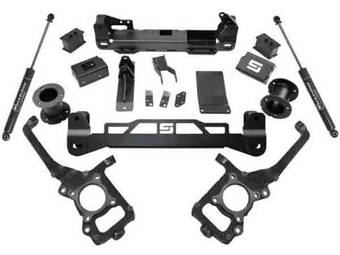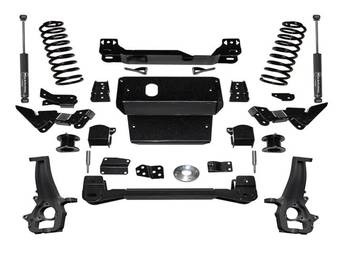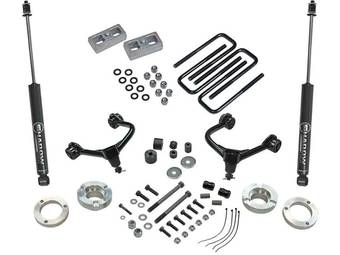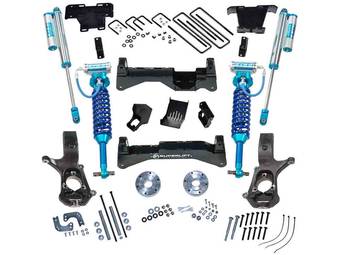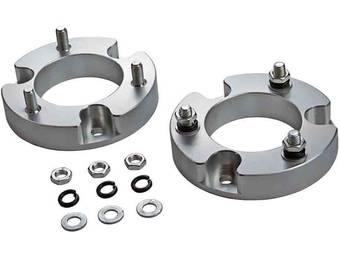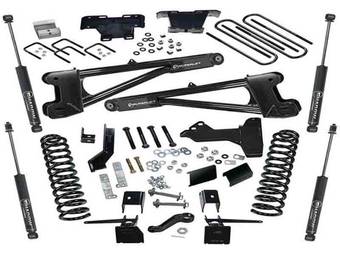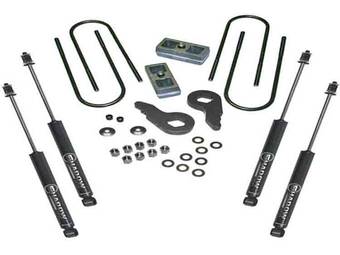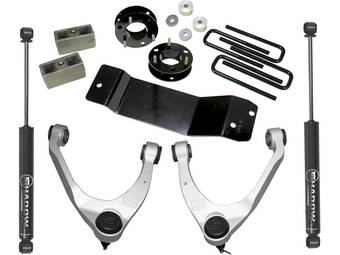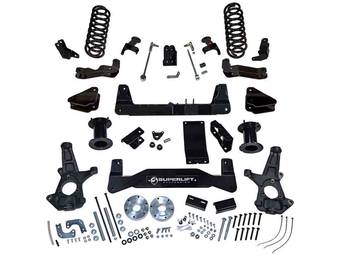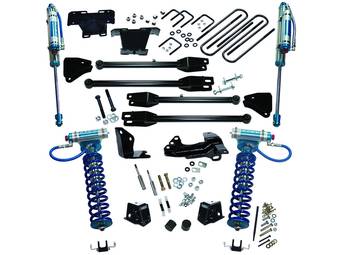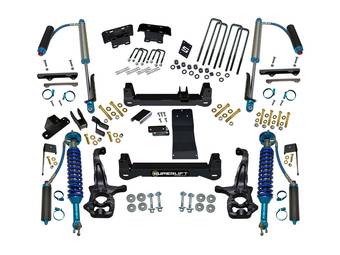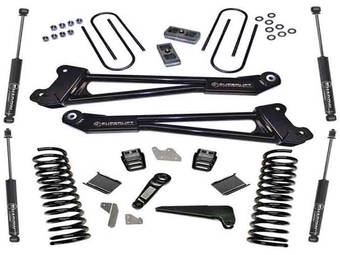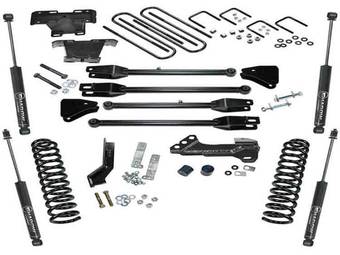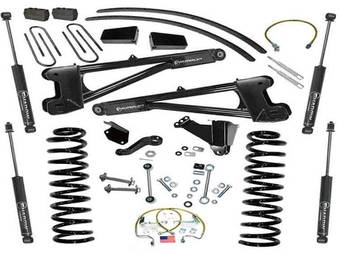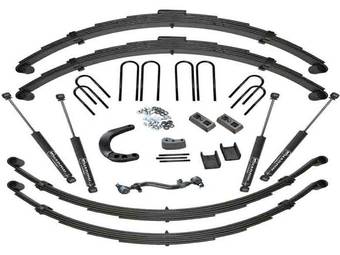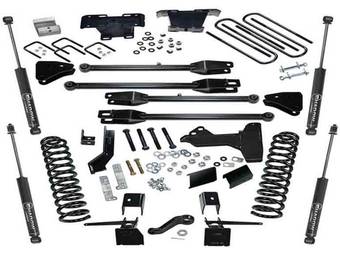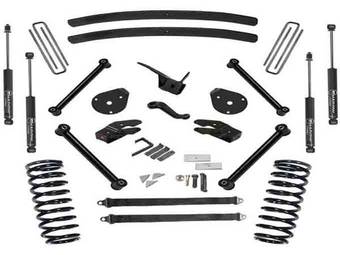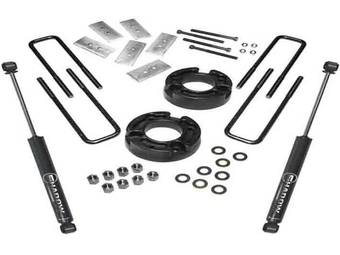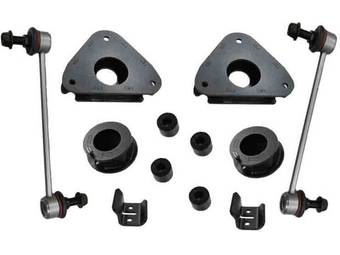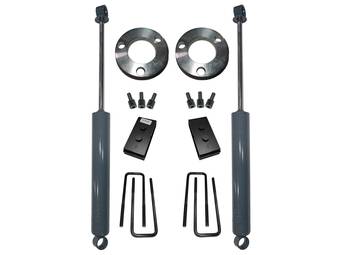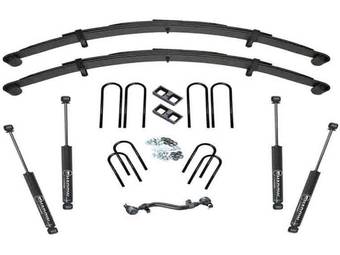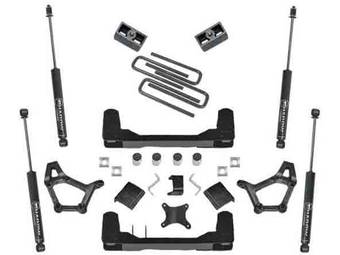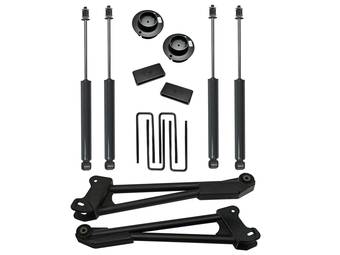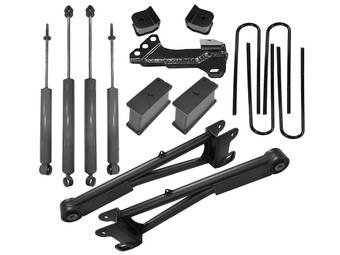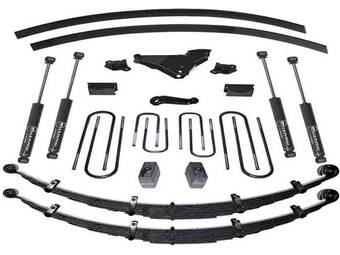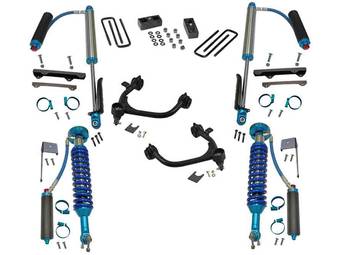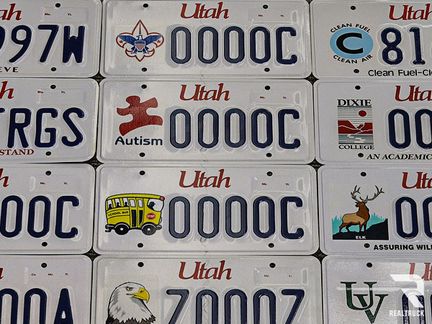Free Shipping on Orders Over $100
Lift Kit Laws by State: Rules and Guidelines for Lift Enthusiasts
Updated on Apr 15, 2025
There’s nothing quite like hitting the open road in a lifted truck, unless you’re anxious about being stopped by the cops. Every state has its unique lifted truck laws, and no two states are exactly alike. Even if you plan to spend most of your time off-road, you must comply with local rules and regulations to ensure your ride remains road-legal.
While local governments deciding what you can and can’t do with your own property may seem arbitrary, these laws aren’t put in place without cause. Lift rules emphasize safety, ensuring modifications to your vehicle won’t place other drivers or yourself in harm’s way. Some regulations limit the height of lifted trucks, while others mandate specific safety requirements. It all depends on where you live.
As the owner of a lifted truck, it’s your responsibility to stay updated with your area’s lifted truck laws. These laws are subject to change, so take a moment to contact your local law enforcement and government offices for up-to-date information before investing in a new lift kit.
If you’re traveling across state lines, research the lift laws of your destination state and all the municipalities in between. Here’s our state-by-state breakdown of all the lift laws you need to know.
NOTE:
Regarding frame height, most states measure from the center of your tail lights or headlights down to the pavement. Keep a tape measure handy to ensure your vehicle complies with the law.
Alabama
Alabama is pretty lax when it comes to suspension requirements. Currently, no laws limit suspension lifts, frame height, or bumper height. Residents can install truck lift kits, aftermarket wheels, tires, shocks, and bumpers. However, your vehicle must be in good condition and meet safety and visibility requirements before hitting the road.
Regarding light height, headlights must be no taller than 54 inches, while tail lights cannot exceed 60 inches. The total vehicle and load height are limited to 13 feet 6 inches.
Alaska
There are no laws covering a vehicle’s suspension, but the vehicle body must be no higher than three inches above the top of the frame. All aftermarket parts are allowed as long as they are in good condition. Regarding light height, headlights must not exceed 54 inches from the ground.
Arizona
Truck and Jeep lift kits are allowed so long as you use mud flaps and fenders. There are no frame height or suspension restrictions. Overall vehicle load height is limited to 13 feet 6 inches. Regarding light height, headlights must not exceed 54 inches, while tail lights cannot exceed 72 inches.
Arkansas
You can modify your lifted truck as you see fit in Arkansas. There are no suspension lift, frame height, or body lift laws in place, so enjoy the open road.
Regarding overall height limitations, a vehicle or load may not exceed 13 feet 6 inches. Headlights must not exceed 54 inches, tail lights cannot exceed 72 inches, and reflectors should not be mounted over 60 inches from the ground.
California
California has considerably more strict lift kit laws in place. The lowest point of a vehicle’s body cannot exceed five inches taller than the top of the frame. Aftermarket parts are allowed—however, strict height limitations exist. Headlights must be no taller than 54 inches, and tail lights no taller than 72 inches.
Maximum frame height is determined by GVWR—maximum frame height for vehicles 4,500 pounds or less is 27 inches, 4,501 to 7,500 pounds is 30 inches, and 7,501 to 10,000 pounds is 31 inches. Vehicles under 4500 pounds are limited to 22-inch-tall bumpers, while those numbers increase to 27 inches up front and 29 inches in the rear for vehicles weighing in at 4,501 to 7,500 pounds. Overall vehicle height can not exceed 14 feet.
Colorado
Colorado’s lift laws can throw some drivers for a loop. While the state says the manufacturer’s original design must not be altered, suspension lifts are allowed as long as they are of the same design as the factory suspension system.
Regarding height limits, a vehicle’s headlights must be no taller than 54 inches, and tail lights must be no taller than 72 inches. Overall vehicle height can not exceed 13 feet.
Connecticut
Suspension lift kits can be no higher than four inches, fenders are required for all four wheels, and bumper height cannot exceed 30 inches. Aside from that, you’re free to modify your truck or Jeep as you see fit.
Regarding height limits, a vehicle’s headlights must be no taller than 54 inches, and tail lights must be no taller than 72 inches. Overall vehicle height can not exceed 13 feet 6 inches.
Delaware
The maximum distance between the lowest point of a vehicle’s body and the top of the frame cannot exceed three inches, while the bumper height can be no higher than 30 inches. Your brakes must be capable of stopping the vehicle within 30 feet when traveling at speeds of 20 mph. A second mechanical parking brake is also required.
Regarding height limits, a vehicle’s headlights must be no taller than 54 inches, and tail lights must be no taller than 72 inches. Overall vehicle height can not exceed 13 feet 6 inches.
Florida
Max bumper height depends on the vehicle’s gross vehicle weight rating (GVWR). Vehicles under 2,000 GVWR have a max bumper height of 24 inches on the front and 26 inches on the rear. Vehicles with a GVWR of 2,000 to 2,999 have a max bumper height of 27 inches on the front and 29 inches on the rear. Vehicles with a GVWR of 3,000 to 3,999 have a max bumper height of 28 inches on the front and 30 inches on the rear. Vehicles with a GVWR over 5,000 pounds are exempt.
Regarding height limits, a vehicle’s headlights must be no taller than 54 inches. Maximum vehicle height cannot exceed 13 feet 6 inches.
Georgia
Suspension lifts are limited to just two inches, making Georgia less off-road friendly than expected, although you can still install aftermarket parts. Frame height is determined by GVWR, with vehicles under 4500 pounds being limited to 27 inches from the surface of the street to the lowest point on the frame, vehicles between 4501 and 7500 pounds limited to 30 inches, and vehicles between 7501 and 14000 pounds limited to 31 inches. Additionally, the disparity between front and rear fender heights cannot exceed four inches.
Regarding height limits, a vehicle’s headlights must be no taller than 54 inches, and tail lights must be no taller than 60 inches. Overall vehicle height can not exceed 13 feet 6 inches.
Top-Selling Lift Kits and Accessories
Check out some of the top rated products that are field-tested and tough enough for anything your truck, Jeep, or SUV can throw at them.
Hawaii
Body lifts are limited to just three inches. However, vehicles are limited by frame and bumper height. Vehicles under 4,500 GVWR have a max bumper and rear height of 29 inches. Vehicles with a GVWR of 4,501 to 7,500 have a max bumper and rear height of 33 inches. Vehicles with a GVWR of 7,501 to 10,000 have a max bumper and rear height of 35 inches. Vehicles with a GVWR of over 10,000 are exempt.
Regarding height limits, headlamps must not be taller than 54 inches, and the maximum vehicle height cannot exceed 14 feet.
Idaho
With few off-road restrictions in place, Idaho is a great place to explore the open road. Bumper height is limited to 30 inches for 4x4s with a GVWR under 10,000 pounds.
Regarding height limits, a vehicle’s headlights must be no taller than 54 inches, and tail lights must be no taller than 72 inches. Overall vehicle height can not exceed 14 feet.
Illinois
Your vehicle’s bumper cannot be raised or lowered by over three inches. Vehicles with a GVWR under 4,500 have a max frame height of 24 inches and a max bumper height of 24 inches in the front and 26 inches in the rear. Vehicles with a GVWR from 4,501 to 7,500 have a max frame height of 26 inches and a max bumper height of 27 inches in the front and 29 inches in the rear. Vehicles with a GVWR from 7,501 to 10,000 have a max frame height of 28 inches and a max bumper height of 28 inches in the front and 30 inches in the rear.
Body lifts are also restricted, as the lowest point of a vehicle’s body cannot exceed four inches above the top of the frame. Total vehicle height is limited to 13 feet 6 inches.
Indiana
Bumpers must be no higher than 30 inches and cannot vary from factory locations by over three inches.
Regarding overall height limitations, a vehicle or load may not exceed 13 feet 6 inches. Headlights must not exceed 54 inches, tail lights cannot exceed 72 inches, and reflectors should not be mounted over 60 inches from the ground.
Iowa
As of 2025, the state has a pending law that would limit frame height to 23 inches and body lifts to five inches, but the state currently has no restrictions in place.
Regarding height limitations, total vehicle height cannot exceed 13 feet 6 inches, and reflectors cannot exceed 42 inches.
Kansas
There are no restrictions in place for body lifts or suspension systems.
Regarding overall height limitations, a vehicle or load may not exceed 14 feet. Headlights must not exceed 54 inches, tail lights cannot exceed 72 inches, and reflectors should not be mounted over 60 inches from the ground.
Kentucky
There are no restrictions in place for body lifts or suspension systems. However, a vehicle cannot exceed 11 feet 6 inches in overall height. Headlights are also limited to 54 inches from the ground.
Louisiana
There are no restrictions in place for body lifts or suspension systems. So long as a vehicle has at least four inches of ground clearance, you’re ready to roll.
Regarding height limitations, a vehicle’s headlights can be no more than 54 inches from the ground, fog light 30 inches, and tail lights 72 inches. Maximum vehicle height shall not exceed 13 feet 6 inches.
Maine
The state has strict frame height limitations in place. Vehicles with a GVWR under 4,501 have a max frame height of 24 inches in the front and 26 inches in the rear. Vehicles with a GVWR from 4,501 to 7,500 have a max frame height of 27 inches in the front and 29 inches in the rear. Vehicles over 7,501 GRWR have a max frame height of 28 inches in the front and 30 inches in the rear.
Regarding height limitations, a vehicle’s headlights can be no more than 54 inches from the ground, and the maximum vehicle height should not exceed 13 feet 6 inches.
Maryland
Bumper and frame height must not exceed 20 inches for cars and SUVs, with a 28-in. limit for trucks. Pickup trucks over 10,000, but not more than 18,000 pounds, are limited to 32 inches.
Regarding height limitations, a vehicle’s headlights can be no more than 54 inches from the ground, tail lights cannot be over 72 inches from the ground, and maximum vehicle height shall not exceed 13 feet 6 inches.
Massachusetts
Suspension lifts are limited to just two inches. Maximum vehicle height shall not exceed 13 feet 6 inches.
Michigan
Lift blocks are not allowed on front springs, and rear lift blocks must not exceed four inches. Coil spring spacers are also outlawed. Additionally, vehicles under 4,501 GVWR have a max frame height of 24 inches and a max bumper height of 26 inches. Vehicles from 4,501 to 7,500 GVWR have a max frame height of 24 inches and a max bumper height of 28 inches. Vehicles over 7,501 GVWR have a max frame height of 26 inches and a max bumper height of 30 inches.
Regarding height limitations, headlights cannot exceed 54 inches from the ground, and total vehicle height cannot exceed 13 feet 6 inches. This standard is waived for registered historical vehicles that do not meet these requirements in factory form.
Minnesota
The bumper height must be within six inches of the factory location. The max bumper height for a four-wheel drive is 25 inches, with two-wheel drives limited to 20 inches. Bumpers must be at least 4.5 inches tall and extend 10 inches outside the frame rail. Bumpers must be attached in at least four places.
Regarding height limitations, maximum vehicle height may not exceed 13 feet 6 inches.
Mississippi
Mississippi limits lift height to eight inches, including tires, and six inches for suspension alone. Following the squatted truck craze, the state also bans vehicles where the front fender height exceeds four inches taller than the rear fender height. Reflector height cannot exceed 60 inches, and maximum vehicle height cannot exceed 13 feet 6 inches.
Missouri
Bumpers must be at least 4.5 inches tall. Vehicles under 4,501 GVWR have a max bumper height of 24 inches in the front and 26 inches in the back. Vehicles with a GVWR from 4,501 to 7,500 have a max bumper height of 27 inches in the front and 29 inches in the back. Vehicles with a GVWR from 7,501 to 9,000 have a max bumper height of 28 inches in the front and 30 inches in the back. Vehicles with a GVWR from 9,001 to 11,500 have a max bumper height of 29 inches in the front and 31 inches in the back.
Regarding height limitations, maximum tail light height cannot exceed 72 inches, and total vehicle height may not exceed 14 feet.
Montana
There are no restrictions in place for body lifts or suspension systems. Height limitations restrict headlights to 54 inches, tail lights to 72 inches, reflectors to 60 inches, and total vehicle height to 14 feet.
Nebraska
There are no restrictions in place for body lifts or suspension systems. However, mud flaps are required and must cover the entire width of the vehicle’s tires. Additionally, the maximum vehicle height is limited to 14 feet 6 inches.
Nevada
Vehicles under 4,501 GVWR have a max body height of 28 inches. Vehicles with a GVWR of 4,501 to 7,500 have a max body height of 30 inches. Vehicles with a GVWR of 7,500 to 10,000 have a max body height of 32 inches.
Regarding light heights, headlights cannot exceed 54 inches from the ground, tail lights cannot exceed 72 inches, reflectors cannot exceed 60 inches, and max vehicle height cannot exceed 14 feet.
New Hampshire
Bumper height is limited to a total of 30 inches. Headlights must be below 54 inches from the ground, while tail lights cannot exceed 72 inches. Total vehicle height cannot exceed 13 feet 6 inches.
New Jersey
As one of the strictest states in the country, New Jersey requires safety inspections for all lifted vehicles, with strict tire, wheel, brake, steering, bumper, and suspension requirements in place.
The maximum lift cannot exceed seven inches for vehicles under 4500 pounds, nine inches for vehicles above 4501 to 7500 pounds, and 11 inches for vehicles between 7501 and 10000 pounds. Maximum vehicle height cannot exceed 13 feet 6 inches.
New Mexico
There are no restrictions in place for body lifts or suspension systems. However, maximum height limits exist for headlights, tail lights, and overall height.
In New Mexico, headlights cannot exceed 54 inches, tail lights cannot exceed 72 inches, and total vehicle height cannot exceed 14 feet.
New York
While the state has few restrictions in place, all cars and SUVs must have front and rear bumpers. The max bumper height for trucks is 30 inches.
Maximum headlight height cannot exceed 54 inches, tail lights cannot exceed 72 inches, and total vehicle height cannot exceed 13 feet 6 inches.
North Carolina
While North Carolina doesn’t place specific restrictions on overall height, the state does outlaw vehicles that, due to alterations to the chassis or suspension, demonstrate a front fender height four or more inches greater than the height of the rear fender. This is due in part to the “squatted truck” movement, which gained popularity in the past few years.
Additionally, maximum headlight height cannot exceed 42 inches, and total vehicle height cannot exceed 13 feet 6 inches.
North Dakota
Suspension lifts are limited to four inches, with a maximum body height of 42 inches. Bumper height is limited to 27 inches, and tires larger than 44 inches are prohibited. No suspension, steering, or braking system modifications are allowed on vehicles weighing less than 7000 pounds.
Headlights are limited to 54 inches from the ground, tail lights are limited to 72 inches, and maximum total vehicle height is limited to 14 feet.
Ohio
Cars and SUVs have a max bumper height of 22 inches in the front and 22 inches in the rear. Vehicles under 4,501 GVWR have a max bumper height of 24 inches in the front and 26 inches in the rear. Vehicles with a GVWR of 4,501 to 7,500 have a max bumper height of 27 inches in the front and 29 inches in the rear. Vehicles with a GVWR of 7,500 to 10,000 have a max bumper height of 28 inches in the front and 31 inches in the rear.
The difference in height between the top of the frame and the lowermost portion of the body can also not exceed four inches. Total vehicle height is capped at 13 feet 6 inches.
Oklahoma
There are no restrictions in place for body lifts or suspension systems. Height limitations restrict headlights to 54 inches, tail lights to 72 inches, and total vehicle height to 13 feet 6 inches.
Oregon
There are no restrictions in place for body lifts or suspension systems. Height limitations restrict headlights to 54 inches and total vehicle height to 14 feet.
Pennsylvania
Front lift blocks are not allowed in the state, while rear lift blocks are limited to five inches. Cars and SUVs have a max bumper height of 22 inches in the front and 22 inches in the rear.
Vehicles under 5,001 GVWR have a max bumper height of 24 inches in the front and 26 inches in the back. Vehicles with a GVWR from 5,001 to 7,000 have a max bumper height of 27 inches in the front and 29 inches in the back. Vehicles with a GVWR from 7,001 to 9,000 have a max bumper height of 28 inches in the front and 30 inches in the back. Vehicles with a GVWR from 9,001 to 11,000 have a max bumper height of 30 inches in the front and 30 inches in the back.
Regarding height limitations, headlights are limited to 54 inches off the ground, tail lights to 72 inches, and total vehicle height cannot exceed 13 feet 6 inches.
Rhode Island
Suspension lift kits are limited to just four inches in Rhode Island. Regarding height limitations, headlights are limited to 54 inches off the ground, tail lights to 72 inches, and total vehicle height cannot exceed 13 feet 6 inches.
South Carolina
South Carolina restricts suspension modifications for most vehicles to 6 inches above or below factory heights. However, this rule excludes pickup trucks. Following the squatted truck craze, the state also bans vehicles where the front fender height exceeds four inches taller than the rear fender height.
Regarding height limitations, headlights are limited to 54 inches off the ground, tail lights to 60 inches, and total vehicle height cannot exceed 13 feet 6 inches.
South Dakota
There are no restrictions in place for body lifts or suspension systems. Maximum tail light height cannot exceed 72 inches, while total vehicle height cannot exceed 14 feet 3 inches.
Tennessee
Front lift blocks are prohibited. Cars and SUVs have a max frame height of 22 inches. Vehicles under 4,501 GVWR have a max frame height of 24 inches. Vehicles between 4,501 and 7,500 GVWR have a max frame height of 26 inches. Vehicles from 7,501 to 10,000 GVWR have a max frame height of 28 inches. Additionally, the lowest part of a vehicle’s body cannot exceed 4 inches above the top of the frame.
The Carolina Squat laws also made their way to Tennessee, as vehicles in the state cannot operate when the front fender is four or more inches higher than the rear.
Total vehicle height cannot exceed 13 feet 6 inches.
Texas
There are no restrictions in place for body lifts or suspension systems. However, headlights cannot exceed 54 inches from the ground, and tail lights cannot exceed 72 inches. Total vehicle height is limited to 13 feet 6 inches.
Utah
Vehicles under 4,500 GVWR have a max frame height of 24 inches. Those with a GVWR between 4,500 and 7,499 have a max frame height of 26 inches, and those over 7,500 have a max frame height of 28 inches.
Body lifts are also restricted, as the height of the lowest portion of the body cannot exceed 3 inches taller than the top of the frame. Total vehicle height cannot exceed 14 feet.
Vermont
There are no restrictions in place for body lifts or suspension systems. Total vehicle height cannot exceed 13 feet 6 inches.
Virginia
Front lift blocks are not allowed. Vehicles under 4,501 GVWR have a max bumper height of 28 inches in the front and rear. Vehicles between 4,501 and 7,500 have a max bumper height of 29 inches in the front and 30 inches in the back. Vehicles above 7,501 have a max bumper height of 30 inches in the front and 31 inches in the back.
Carolina squat laws also apply in Virginia, as vehicles in the state cannot operate when the front fender is four or more inches higher than the rear. Total vehicle height is also limited to 13 feet 6 inches.
Washington
Cars and SUVs have a max bumper height of 22 inches in the front and back. Vehicles under 4,501 GVWR have a max bumper height of 24 inches in the front and 26 inches in the rear. Vehicles between 4,501 and 7,500 GVWR have a max bumper height of 27 inches in the front and 29 inches in the rear. Vehicles with GVWR of 7,501 and over have a max bumper height of 28 inches in the front and 30 inches in the rear.
Body lifts are restricted to three inches, and the total distance between the body and the top of the frame cannot exceed four inches. Additionally, all lift kits must be engineered for the particular make and model and installed according to manufacturer instructions.
Regarding height limitations, headlights cannot exceed 54 inches from the ground, tail lights cannot exceed 72 inches, and total height cannot exceed 14 feet.
West Virginia
Bumper height is limited to 31 inches, and body lifts are limited to just three inches. Headlights must be no more than 54 inches from the ground, and tail lights are limited to 60 inches from the pavement. Total vehicle height is limited to 13 feet 6 inches.
Wisconsin
All pickup trucks must have rear bumpers. Car bumpers must be within two inches of the factory bumper height, and trucks must be within nine inches of the factory bumper height. Suspension lifts are limited to four inches, and tires cannot exceed four inches above factory sizing.
Regarding height limitations, headlights must be no more than 54 inches from the ground, and tail lights are limited to 72 inches. Total vehicle height is limited to 13 feet 6 inches.
Wyoming
There are no restrictions in place for body lifts or suspension systems. Total vehicle height cannot exceed 13 feet 6 inches.
Look for the States Where You’ll Be Driving
As you can see, lift kit laws vary dramatically by state. Keep this information in mind when shopping for truck and Jeep lift kits on RealTruck.
Lift Kit Laws FAQs
Q: Are lift kits legal?
A: Yes, so long as the system adheres to local laws and regulations.
Q: How high can your truck be lifted legally?
A: Lift kit height limits vary by state, with some restricting lifts to just two inches. Consult the laws above to learn the lift height allowance of each state.
VIDEO: Top Lifted Trucks of SEMA 2016
Shop Now
RealTruck is your home for the best products to outfit your build for unforgettable adventures.
Wheels and Tires | Interior Lights | Steering Upgrades | Hitches and Towing
See More US State License Plate Articles Here...
Join over 2 million RealTruck people
Get exclusive savings, insider information, and the latest RealTruck articles sent straight to your inbox.
